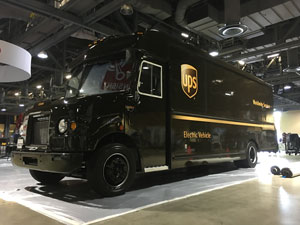In the back parking lot of BYD Motors Inc.’s Lancaster facility, prototypes of electric trucks wait their turn as the company’s future. But for now, electric buses are still rolling off the factory line inside BYD’s plant as a major part of the company’s finances. Eventually, though, sales of electric trucks may one day eclipse those of the buses. Andy Swanton, director of business development at BYD, said new bus sales top out at about 4,500 units a year. In contrast, the step van, one of the five truck models that BYD will bring to market in upcoming years, has annual estimated sales in the 15,000-unit range. “So we are talking about three times that size with just one platform,” Swanton said. In addition to the step van – the classic freight delivery vehicle used by United Parcel Service Inc. and others – BYD is developing two box delivery trucks, a drayage truck and a yard tractor. The last two vehicles would be marketed to sea ports to move shipping containers within the immediate areas. The buses and the trucks use interchangeable parts, namely the battery packs, assembled at a separate facility in Lancaster. Inverters convert power to the motors, brakes and steering, while integrated motors are built into the axle to improve efficiency. “In the future, we will assemble them similar to how we do the buses here at our plant,” Swanton said. Greener horizons BYD Motors is the U.S. subsidiary of Chinese electric vehicle and battery manufacturer BYD Co. Ltd. The company opened its Lancaster plant in spring 2013 and employs 300 people between Lancaster and its headquarters in downtown Los Angeles. The manufacturer began delivering buses a year later, and its first customer was the Antelope Valley Transit Authority. BYD’s electric bus business is moving ahead with strong volume. The company has contracts with Los Angeles County Metropolitan Transportation Authority, or Metro, and the Washington State Department of Transportation. In May, workers were assembling vehicles for Long Beach Transit and Stanford University. But waiting in the wings are the electric trucks. The company has already retrofitted a UPS step van with its battery technology and displayed the vehicle in early May at the Advanced Clean Transportation Expo in Long Beach. Single model trucks have been shipped from China. A $23.6 million state grant from the South Coast Air Quality Management District will pay for five of the drayage trucks to be made this year and an additional 20 trucks next year, Swanton said. They will be used as demonstration vehicles to reduce emissions at the ports of Los Angeles and Long Beach, which handle up to 40 percent of goods imported to the U.S. Plus, coming down the pike is Gov. Jerry Brown’s mandate, announced last July, for freight vehicles in the state to be emission free or nearly so and to be powered by renewable energy sources. His executive order doesn’t give a deadline for those requirements, just that state transportation and environmental agencies have a year to come up with a plan on how to bring the goals to fruition. “Goods movement is a huge potential market for us,” Swanton said. Green benefits The benefit of electric trucks is the money they save on fuel and maintenance. Average savings are estimated at about $10,000 annually, according to Swanton, and that figure will increase if gas prices go up. The initial outlay for the electric vehicles, on the other hand, can be two to three times the amount of a diesel vehicle. A diesel step van can cost $75,000 while a similar vehicle from BYD can cost up to $175,000. The state does have a program that will pick up the cost differential. Patrick Couch, vice president of technical services at the Irvine office of Gladstein, Neandross & Associates, a clean transportation and alternative energy business which organized the Advanced Clean Transportation Expo that BYD appeared at in May, said that nearly every electric truck now operating in California has received that incentive. “It is critical at this point to make the business case for an (electric vehicle) to buy down some of that incremental cost,” Couch said. Jon Leonard, senior vice president of Gladstein, Neandross, said that even though battery technology that can support long-haul trucking does not currently exist, the market looks promising for the shorter-range applications BYD is targeting. The California Air Resources Board, when assessing alternative fuel vehicles, is pragmatic about the penetration rate of electric trucks in the next decade, Leonard said. “They limit their estimated penetration to what they call last-mile delivery trucks – the short range, smaller vehicles,” he added. As the one who is overseeing truck production in Lancaster, Swanton envisions ambitious plans for the vehicles. For one, there are plans to market trash-hauling trucks using the large chassis box model. BYD will start with an automated side-loading hauler for residential collection. A prototype will be built in China that will arrive in the U.S. early next year, Swanton said. Other potential future uses include construction vehicles, such as dump trucks and cement mixers, and ore haulers for mining, Swanton said. “(The refuse trucks) won’t cover all applications, but for city fleets that do residential pickup, it’s a great application,” he added.
